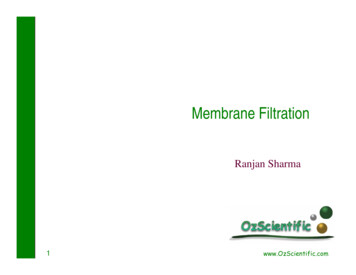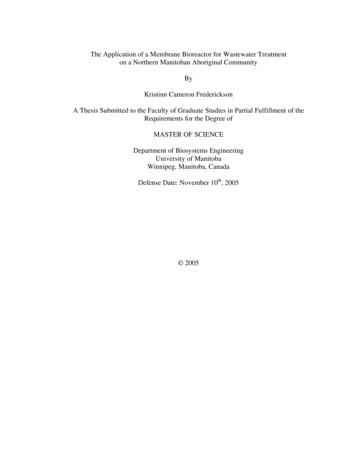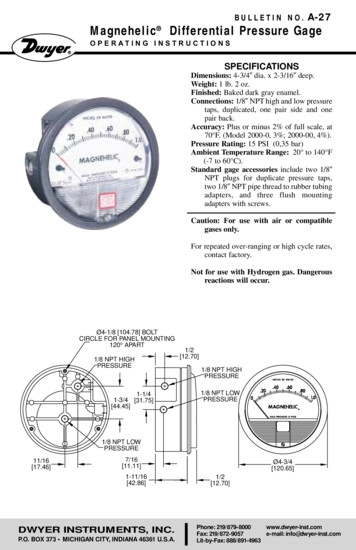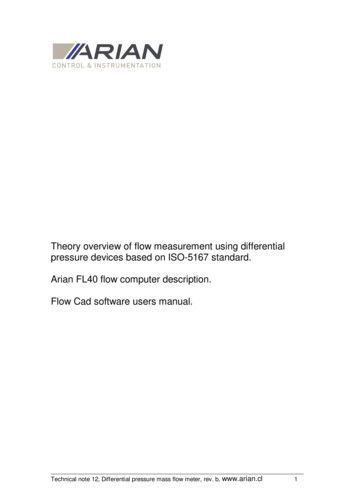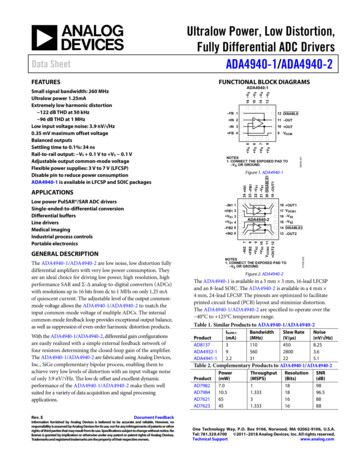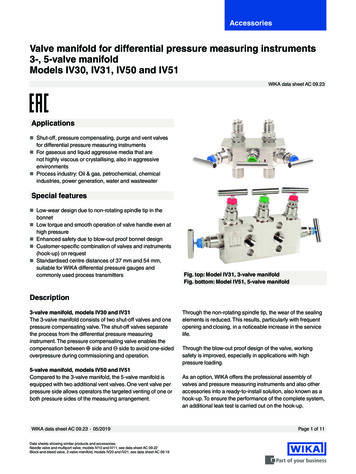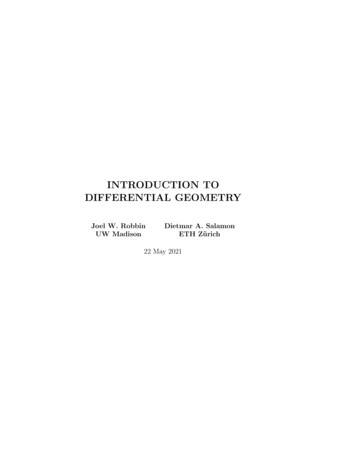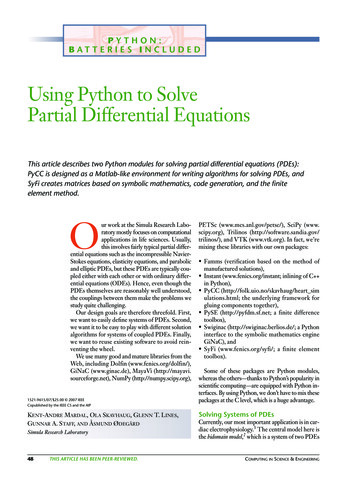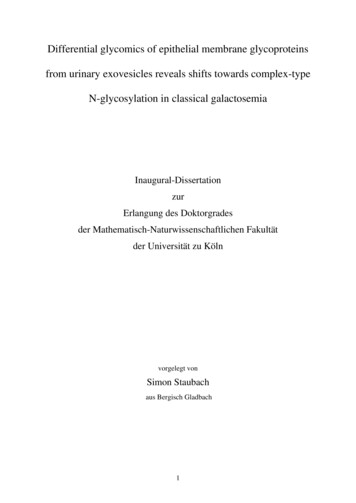
Transcription
Differential glycomics of epithelial membrane glycoproteinsfrom urinary exovesicles reveals shifts towards complex-typeN-glycosylation in classical galactosemiaInaugural-DissertationzurErlangung des Doktorgradesder Mathematisch-Naturwissenschaftlichen Fakultätder Universität zu Kölnvorgelegt vonSimon Staubachaus Bergisch Gladbach1
Differential glycomics of epithelial membrane glycoproteinsfrom urinary exovesicles reveals shifts towards complex-typeN-glycosylation in classical galactosemiaInaugural-DissertationzurErlangung des Doktorgradesder Mathematisch-Naturwissenschaftlichen Fakultätder Universität zu Kölnvorgelegt vonSimon Staubachaus Bergisch Gladbach2
Berichterstatter:(Gutachter)Prof. Dr. Franz-Georg HanischProf. Dr. Marcel BucherTag der mündlichen Prüfung: 14. Mai 2012The present research work was carried out under thesupervision and the direction ofProf. Dr. Franz-Georg HanischInstitute of Biochemistry IIMedical Faculty, University of CologneCologne, Germany,February 1st, 2009 to Mai 14th, 2012The second supervisor wasProf. Dr. Marcel Bucher3
1. Directory1. Directory . 41.2 Tables of figures . 61.2.1 Table of figures . 61.2.2 Table of supplements . 71.2.3 Table of Excel-Tabs . 71.3 Abbreviation . 81.4 Synopsis . 102. Introduction . 122.1.1 Galactose-1-phosphate uridyltransferase (GALT) . 122.1.1.1 GALT 3D structure . 122.1.1.2 The GALT mutation Q188R . 132.1.1.3 Ping-Pong double displacement reaction of GALT . 132.1.2 Galactose and the Leloir pathway . 142.1.3 Dysglycosylation of secreted glycoproteins in classical galactosemia . 162.1.4 Clinical picture of classical galactosemia . 162.1.5 Exosomes . 172.1.5.1 Characteristics of exosomes . 172.1.5.2 Epithelial origin of exosomoes . 182.1.5.3 Exosomes are enriched in subpopulations of lipid rafts . 182.1.6 Lipid rafts . 192.1.6.1 Lipid raft endocytosis . 192.1.6.2 Glycoprotein trafficking via multivesicular bodies (MVB’s) to exosomes . 202.1.7 The Tamm-Horsfall glycoprotein (THP) . 212.1.8 N-glycan processing . 222.1.9 Reabsorption of proteins in the kidney . 232.1.9.1 Megalin cubilin receptor complex. 232.2 The aims of the study . 253. Materials & Methods . 253.1 Materials . 253.1.1 Samples from GALT deficient patients . 253.1.2 SDS-Polyacrylamide-gel electrophoresis buffers . 263.1.3 Transfer buffer for Wet blot . 263.1.4 Other buffers . 263.1.5 SDS-polyacrylamide gels . 273.1.6 Inhibitors . 273.1.7 Staining solutions and dye. 273.1.8 N-glycan detachment / methylation . 283.2 Methods . 283.2.1 BioRad DC protein assay for high concentration. 283.2.2 Preparation of urinary exovesicles . 283.2.3 Electron microscopy of exovesicular preparations . 293.2.4 Isolation of Tamm-Horsfall protein . 293.2.5 Release and purification of N-linked glycans . 303.2.6 Derivatization of N-linked glycans . 303.2.7 MALDI-TOF-TOF mass spectrometry of methylated glycans . 303.3 Differential proteomics by application of the i-TRAQ-technology . 313.3.1 Preparation of lipid rafts out of urinary exovesicles . 313.3.2 Protein quantitation in the context of i-TRAQ experiments . 313.3.3 Chloroform / methanol-precipitation . 324
3.3.4 Filter assisted sample preparation (FASP) . 323.3.5 iTRAQ labeling . 333.3.6 MALDI Spotting . 333.3.7 LC-MALDI MS/MS analysis . 343.3.8 Database Searches . 343.4 Identification of exosomal vesicles by detection of marker proteins in density gradientfractions . 353.4.1 Preparative gradient centrifugation of urinary vesicles. 353.4.2 Detection of exosomal marker proteins by Western blot . 353.4.3 Antibodies . 364. Results . 374.1. Vesicle classification by electron microscopy and exosomal marker proteins . 374.2 N-glycosylation of exosomes . 384.2.1 Differential N-glycomics of the urinary exovesicles from galactosemia patients andhealthy controls . 384.2.2 High-mannose and complex-type N-glycans . 404.2.3 Bi-antennary complex-type glycan, the most abundant structure . 424.3 The GPI-anchored transmembrane Tamm-Horsfall Protein . 444.3.1 N-Glycosylation of urinary Tamm-Horsfall Protein (THP) . 444.3.2 Validation of predominant high-mannose-type N-glycosylation of exosomal lipidraft associated THP . 454.4 Differential proteomics of exosomal membranes . 464.4.1. Isobaric tags for relative and absolute quantitation . 464.4.2 Proteins found increased . 474.4.2.1 Serum proteins. 474.4.2.2 ECM-related proteins . 484.4.3 Identification of exosomal raft proteins by LC-ESI of SDS-gel fractions . 495. Discussion . 505.1 A multitude of N-glycosylated proteins . 505.2 Disglycosylation and targeting of glycoproteins . 515.3 Secreted high-mannose-type glycoproteins probably do not recycle through the Golgicompartment . 525.4 Criteria for Tamm-Horsfall Protein being membrane integrated or associated . 535.5 Galactosemia - a secondary dual congenital disorder of glycosylation (CDG) . 536. Conclusion . 546.1 N-Glycan remodelling of high-mannose to complex-type . 546.2 Clinical pictures of renal failure . 556.3 Reasons for detecting serum proteins in urine . 556.4 Hypergalactosylation in samples from galactosemia patients. 566.5 Hypertension in combination with renal failure is dangerous in galactosemia . 577. Future experiments . 587.1 Glycolipids analyzation of urinary exosomes . 588. References . 599. Legends to attached figures . 6210. Legends to supplements . 6711. Attachment . 6712. Kurzzusammenfassung . 9713. Erklärung . 995
1.2 Tables of figures1.2.1 Table of figuresFig. 1: GALT 3D / Source: PDB (Protein Data Bank). GALT complexed with UDP-galactose12Fig. 2: Mislinkage of Arginin 188 / Attm.68Fig. 3: Bulky residue of arginine disturbs dimeric close up of subunits and active sites / Attm. 69Fig. 4: Ping-Pong double displacement reaction of GALT / Attm.70Fig. 5: Leloir Pathway15Fig. 6: Affected organs in galactosemia17Fig. 7: Origin of exosomes19Fig. 8: Glycoprotein travelling via lipid rafts / Attm.71Fig. 9: Tamm-Horsfall protein22Fig. 10: N-glycan processing23Fig. 11: Megalin cubilin reabsorption complex24Fig. 12: N-glycosylation of exosomes / Attm.72Fig. 13: Electron micrograph of exovesicular preparations37Fig. 14: Western blot of marker proteins separated by continuous gradient centrifugation/ Attm.73Fig. 15: Tamm-Horsfall protein contamination of urinary exosomal vesicles / Attm.74Fig. 16: Electron microscopy of 0.1µm filtered exosomes / Attm.75Fig. 17: MALDI mass spectrum exosome derived N-glycans of a galactosemic patient39Fig. 18: MALDI mass spectrum exosome derived N-glycans of a healthy persons39Fig. 19: High-mannose versus complex-type species / Attm.76Fig. 20: Relative amounts of high-mannose-type vs. complex-type N-glycans42Fig. 21: MS2 spectrum of the monosialyl bi-antennary complex-type N-glycan m/z 237743Fig. 22: MS2 spectrum of the high-mannose-type N-glycan M6 m/z 173044Fig. 23: THP removal from urinary-exosomes using DTT / Attm.77Fig. 24: N-glycans electrophoretically purified THP exovesi
Vps vacuolar protein sorting-proteins 1.4 Abstract Classical galactosemia is caused by deficiency of the enzyme galactose-1-phosphate uridyltransferase (GALT). The reason for the deficiency is a specific gene mutation causing an amino acid exchange near the active
